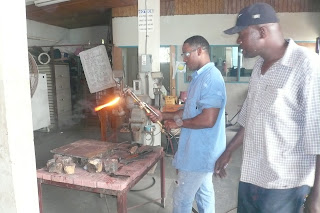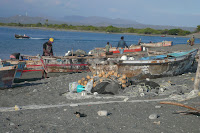Panamá
After a five-day passage from
Jamaica, San Miguel arrived at
Shelter Bay, near the city of Colon. The marina there is a hub for sailors
waiting to transit the Panama Canal. After the boat was measured (apparently
official vessel specifications are not adequate for canal authorities) and
assigned a transit date of April 28, we set off for the San Blas island chain,
which begins about 70 nm northeast of Colon.
The San Blas archipelago is
comprised of around 400 islands stretching from the Panamanian city of
Portobelo to the Colombian border. The islands all appear almost identical;
they’re low and flat, made of white coral sand and are covered with coconut
palms and shrubs. The entire chain is part of a comarca—a semiautonomous reservation—for the Kuna (or Tule)
natives. The Kuna, with a population of 62000, are one of a number of
indigenous peoples that live on different comarcas
throughout Panama. They have taken advantage of tourism, selling their textiles
and hand-woven jewelry with strikingly bright colors.
I met Edgar and his family on the island
of Chichime where they had moved a few months earlier. Their home consisted of
three huts with palm-leaf roofs, hammocks for sleeping, and a fire ring for
cooking. They mainly lived on coconuts and fish, but sometimes bought bread and
produce from the mainland. Edgar, his cousin and I set out with some other
sailors to fish on the reef on the opposite side of the island. Edgar and his
cousin caught some big spider crabs with their bare hands and I managed to
shoot a large jack, part of which I exchanged for one of the crabs.
 Once we arrived back in Shelter Bay
we began preparing to transit the canal. Opened in 1914, the Panama Canal was
one of the greatest engineering feats of its time. An estimated 25000 people
died during its construction, mainly from malaria, typhoid fever, and yellow
fever[1]. The
United States controlled the Canal Zone until the end of 1999 when it was
handed over to Panama. Today on each side of the canal, an additional set of
locks, adjacent to the first, are being constructed to allow a higher volume of
shipping traffic, to be completed in 2013. It costs about US $1500 for a 50-ft
yacht to transit the canal, and up to $500k for container vessels. According to
our canal agent, canal business accounts for 8% of Panamanian gross domestic
product (its third largest contributor, behind sales in the duty-free zone and tourism).
Once we arrived back in Shelter Bay
we began preparing to transit the canal. Opened in 1914, the Panama Canal was
one of the greatest engineering feats of its time. An estimated 25000 people
died during its construction, mainly from malaria, typhoid fever, and yellow
fever[1]. The
United States controlled the Canal Zone until the end of 1999 when it was
handed over to Panama. Today on each side of the canal, an additional set of
locks, adjacent to the first, are being constructed to allow a higher volume of
shipping traffic, to be completed in 2013. It costs about US $1500 for a 50-ft
yacht to transit the canal, and up to $500k for container vessels. According to
our canal agent, canal business accounts for 8% of Panamanian gross domestic
product (its third largest contributor, behind sales in the duty-free zone and tourism).
The canal authorities require that
each private yacht have a captain and at least four others to serve as line-handlers.
For this reason many of the sailors waiting to transit with their own boat will
go through with other boats beforehand, aiding the skipper and scouting out the
process before taking part themselves. Serving as a line-handler is also
popular among travelers who want to experience the canal. Line-handlers are a hot
commodity; all a prospective crewmember has to do is walk down the dock and
inquire with a few boats or put a sign up on the marina message board.
 In this way Francois and I helped a
Dutch family transit the canal on their 47-foot Beneteau Boomerang. At 4 pm we arrived with the boat near the entrance of
Gatun locks, and awaited the arrival of our advisor, who would stay onboard and
guide us through the entire canal. We rafted up with two other sailboats, using
old tires as a buffer between them, and stayed this way until we had passed all
three ascending locks, which we shared with a container vessel and a tugboat.
Upon entering the first lock men on both sides of the raft threw us monkey’s
fists on lines to which we attached our own heavy lines. They hauled up our
lines and attached them to the top of the side walls. The large steel doors
closed and water was allowed to flow from the succeeding uphill lock through
large pipes, creating strong currents and vortices. As the water level rose,
the two boats on the sides of the three-boat raft quickly took up the slack
forming in the lines attaching us to the side walls. Doing this job poorly is
what causes most incidents. After the water level rose to the level of the
second lock, the doors opened and we were allowed to move forward.
In this way Francois and I helped a
Dutch family transit the canal on their 47-foot Beneteau Boomerang. At 4 pm we arrived with the boat near the entrance of
Gatun locks, and awaited the arrival of our advisor, who would stay onboard and
guide us through the entire canal. We rafted up with two other sailboats, using
old tires as a buffer between them, and stayed this way until we had passed all
three ascending locks, which we shared with a container vessel and a tugboat.
Upon entering the first lock men on both sides of the raft threw us monkey’s
fists on lines to which we attached our own heavy lines. They hauled up our
lines and attached them to the top of the side walls. The large steel doors
closed and water was allowed to flow from the succeeding uphill lock through
large pipes, creating strong currents and vortices. As the water level rose,
the two boats on the sides of the three-boat raft quickly took up the slack
forming in the lines attaching us to the side walls. Doing this job poorly is
what causes most incidents. After the water level rose to the level of the
second lock, the doors opened and we were allowed to move forward.
The Panama Canal covers close to 50
miles of waterways. At the Caribbean end there are three consecutive locks
(Gatun Locks) ascending to Lake Gatun. At the Southern end of this lake stands the
Pedro Miguel Lock, which descends to the level of Lake Miraflores. At the end
of this lake the two locks at Miraflores descend to the level of the Pacific
Ocean[2].
Like most canal systems, the locks in the Panama Canal function by gravity
alone, such that water flows downhill from Gatun and Miraflores lakes and into
the ocean, requiring no active water pumping. In fact, the system harnesses
this massive flow of water to generate hydroelectric power. The lakes were
created artificially by damming several rivers, most notably the River Chagres,
which continually supply the lakes with water such that they rarely become low.
In two weeks I passed through the
canal on three different boats. The bus from Panama City on the Pacific side back
to Colon costs around $2.00 US.
After later transiting with San Miguel I returned to Shelter Bay to meet with the crew of Allegra II, who were delivering this
boat from Italy to Australia. They were seeking crew and agreed to take me
along into the Pacific. Allegra II is
a 50-ft Lagoon catamaran built in France in 2007. She is powered by a mainsail
and genoa (1100 and 800 ft2 respectively), two 75-hp Yanmar diesel
engines (each consuming approximately 1.3 l h-1) and a diesel
generator. She has a gennaker (1400 ft2) that draws best between
apparent wind angles of 90° and 150°. She has four staterooms, five
heads, two refrigerators and two freezers. Needless to say life onboard is
comfortable.
Immigration
 Everyone has a story about dealing with the bureaucratic
system in a foreign country and this one is mine. Before arriving I had heard
conflicting stories about the immigration procedure for Panama. Some spoke of a
new law requiring a $110 visa. Some said that the visa was not necessary. Some
said that the visa was required but they in particular had not been asked to
pay. Some said the visa was technically required, but if you planned to simply
pass the canal, you would not be asked for it. Some said if you check into the
country in Panama City the fee is only $10. More disturbing is that the people
relating these requirements were not only foreign sailors, but also
professional government agents. When I signed onto the crew of Allegra II, the agent dealing with our
customs and immigration told me I had not obtained a visa when I entered the
country and it was imperative that I get a visa before being “stamped out” of
the country.
Everyone has a story about dealing with the bureaucratic
system in a foreign country and this one is mine. Before arriving I had heard
conflicting stories about the immigration procedure for Panama. Some spoke of a
new law requiring a $110 visa. Some said that the visa was not necessary. Some
said that the visa was required but they in particular had not been asked to
pay. Some said the visa was technically required, but if you planned to simply
pass the canal, you would not be asked for it. Some said if you check into the
country in Panama City the fee is only $10. More disturbing is that the people
relating these requirements were not only foreign sailors, but also
professional government agents. When I signed onto the crew of Allegra II, the agent dealing with our
customs and immigration told me I had not obtained a visa when I entered the
country and it was imperative that I get a visa before being “stamped out” of
the country.
The first immigration office I arrived at was the wrong one.
I was told to go to 11th St. There I found an unmarked building with
a staircase leading up to several offices. I told the woman at the desk my
situation: I had entered the country as crew on a sailboat two weeks earlier, I
was not aware that I needed a visa and I now planned to get on another boat to
exit the country. Nope. It was impossible that I get the visa without copies of
the former boat’s registration, crew list, cruising permit, a letter from the
captain, two personal ID pictures, and two copies of my passport and entry
stamp. Well. That was going to be impossible, since San Miguel was in a different city. Next try. After passing through
the canal with Allegra II I met with
Francois and obtained copies of San
Miguel’s documents. Next morning. Immigration official at the marina: you
don’t need a visa, we’ll just stamp you out of the country tomorrow. Interesting.
In any case the agent we are using says that’s impossible and the captain wants
it done right. Next try. $20 taxi ride to the immigration office in Panama
City. Woman at the desk: “I guess I can give you a visa if you really want one,
it’s going to cost $100.” Done.
If Panama is going to institute a new law and require $100
visas, they should make the process clear to everyone, including their own
government officials.
















































